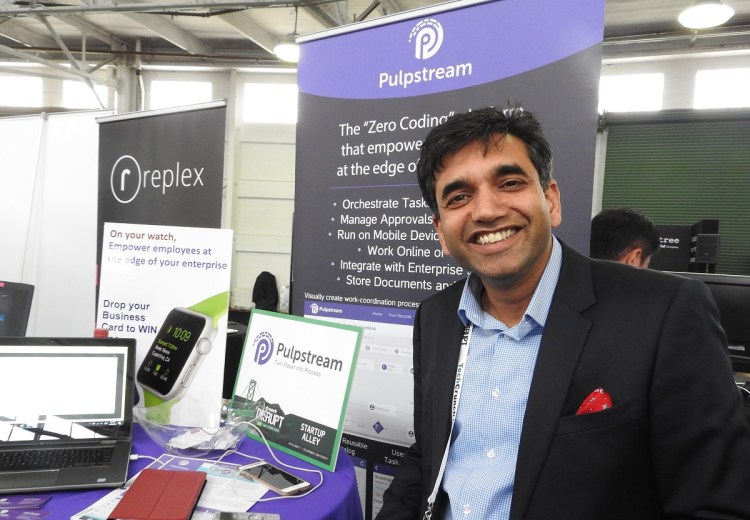Pulpstream has an interesting ambition to get rid of paper-based forms at enterprises and replace them with employee-created digital processes that require zero coding experience to build.

Above: If someone is hurt, you can show where by circling the area with your finger in a Pulpstream form.
This idea comes from the most enthusiastic CEO that I met at Techcrunch Disrupt this week, Pankaj Malviya, the head of Pulpstream. He was introducing a new platform that enables employees to get rid of paper forms and use their mobile devices to do their work. It was our second meeting, as we had met many years ago at a DEMO event when he was pitching an earlier cloud startup called LongJump. He sold that one to Software AG.

Above: Pulpstream form creation.
“You wrote years ago that Pankaj Malviya was giving a high-energy presentation,” Malviya said with a big smile. “I have exactly the same high energy now. I have sold two companies now. I want to make my customers successful.”
Malviya showed me what Pulpstream could do, starting with the creation of a custom form on a mobile device. If the employee is an insurance adjuster, then he or she could create a form for an accident report, with all of the details marked in the right points. You could, for instance, have the employee enter details of the time, place, and nature of the accident.
On an image of the body, you could also circle the part of the body where the injury occurred, and then attach a photo of the injured person. If it was a car accident, you could attach an image of the car, as well. You could even have someone sign a claim form at the scene of the accident, if the adjuster is present, rather than waiting a week for someone to send out that form. You can also pull back and see the flow chart for the digital form to see where it branches.
“I saw that enterprises were struggling with building mobile apps that really empower employees and people,” Malviya said. “After LongJump got acquired, I wanted to build a platform that businesses can use to deploy enterprise tasks to the edge of the network.”
He wanted to push the process of the office paperwork out to the people who are in the field, those who are doing audits, inspections, workers’ comp investigations, or those who are working on products. These are the people with the knowledge to answer relevant questions.
“They can replace paper-based processes with digitized workflows,” Malviya said. “Pulpstream is all about enabling mobile workers.”
The employees are the ones who create the forms, and the process requires no contribution from a programmer. The forms are flexible enough to accommodate many different kinds of businesses, with “zero coding required” to build them, Malviya said. Employees can create these forms within minutes or days. And when they’re in the field, they can fill out reports very quickly, using their mobile phones. The forms work whether the employee is online or offline.
“The problem today is you lose a lot of days before you get an employee’s statement or a witness’s statement in an incident report,” Malviya said. “If the employee is right there in front of me, I get their statement right away. If the person doesn’t want medical treatment, I get the signature on that right then.”
If the employee has to go to the hospital, then you can get the employee’s mobile number and send them a text. The employee can fill out the form on their smartphone later on. All of the data is captured, and then it is sent back to the company, where it can be analyzed.
Mobile-centric, distributed workforces account for approximately 35 percent of the global workforce. Despite the availability of the internet and mobile, remote workers often complete complex transactions using inefficient tools, such as pen and paper, forms completion, scanning, PDFs, spreadsheets, and email.
Businesses across industries from biotech to staffing depend on remote workers in the field to perform critical work, such as incident management, field reporting, workers’ compensation, injury reporting, site audits, inspections, and more. Streamlined workflows are crucial to optimizing productivity rates.

Above: Flowchart for a Pulpstream digital form.
Pulpstream was designed to integrate out of the box with Salesforce data, as well as with DocuSign and EchoSign, in order to support customer-centric business processes, such as deal approvals, customer service, customer on-boarding, and more. That means you’ll be able to fill out a form, get the right signature, sign off on a checklist, and finish it on the mobile device.
“With Pulpstream, we can now rapidly customize our work streams to track information more efficiently — from start to finish. We’ve improved visibility into critical data and automated manual procedures with powerful mobile apps,” stated Robin Coyne, a director of health and safety and environment at Central Garden & Pet, in a statement. “Our line of business managers can readily track HSE performance, determine incident trends, assign corresponding tasks, schedule deadlines, and confirm task completions for our nationwide workforce. Pulpstream has helped us achieve new levels of efficiency, agility, and mobility so we keep a competitive edge.”
Pulpstream is available on the web, Android, iOS, and Microsoft Surface. Pulpstream was founded 2.5 years ago and has a small team. The company is profitable, and it has not raised any funding. Rivals include IBM and other big cloud enterprise companies.
“We are working with a number of different industries now,” Malviya said.


